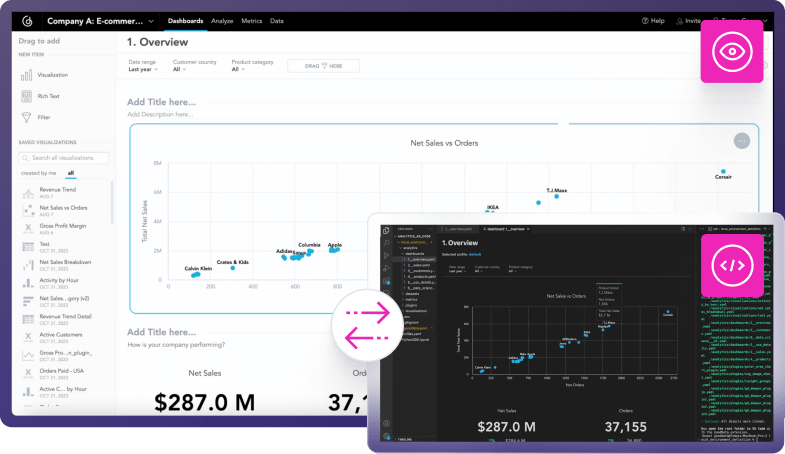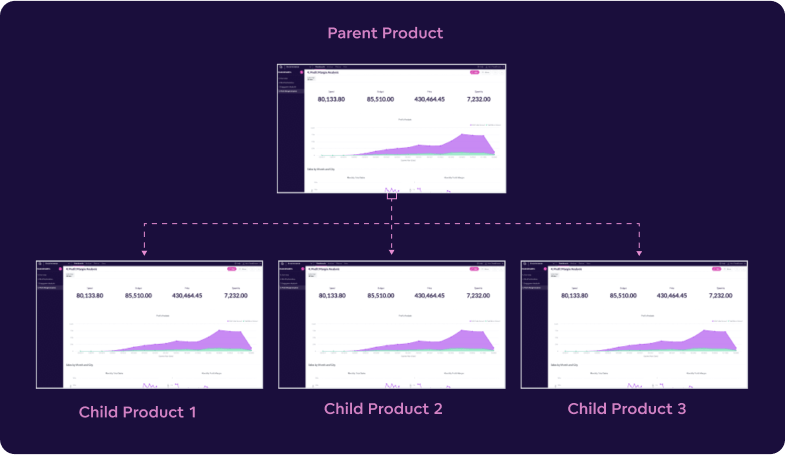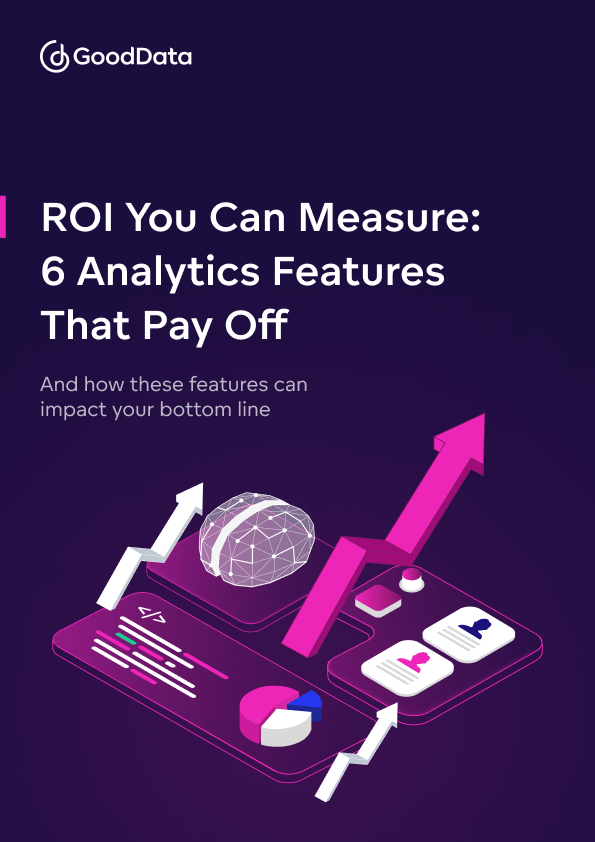Your analytics tool should not only provide insights but drive real value for your business. When it comes to tangible benefits, you should be on the lookout for several features that are designed to reduce costs, boost efficiency, and unlock new revenue opportunities. Today, we’ll show you how these features can impact your bottom line — complete with estimated figures to illustrate potential upsides.
The features we’re about to discuss are designed to drive value across the board. Users who may directly benefit include: analytics engineers, data analysts, and consumers.
Feature 1: Analytics as Code (AaC)
Analytics as code allows teams to manage data processes through code, rather than manual tasks. By automating workflows, resources can be saved that would otherwise be spent on repetitive updates and deployments. Reusable blueprints and templates allow teams to quickly replicate analytics setups across projects, speeding up delivery. AaC also enables bulk changes — meaning updates can be applied across the platform with a few lines of code, rather than individually.
Potential Returns of this Feature
As this case study demonstrates, automation can reduce manual effort by up to 80%.*

Feature 2: Multi-tenant Architecture and Scalability
Multitenancy allows multiple users or teams to share the same analytics platform while keeping their data, settings, and insights securely separated. This setup ensures scalability, as it is easy to accommodate increases in volume, assets, or users without the need for additional tools.
Multitenancy saves time by allowing streamlined management and updates across all users at once. Costs are lower compared to a single-tenant analytics platform (as there is no need to pay for separate versions for each user). Plus, your solution will be future-proof: the platform is designed to support growth and there’s no need to shell out for new software as your analytics needs evolve.
Potential Returns of this Feature
20-25% savings on operational costs compared to single-tenant systems.*

Feature 3: Ability to distribute the analytics experience across all user touchpoints
An optimal analytics platform will ensure seamless data distribution to any downstream experience. There should be the option to seamlessly embed the analytics into your app, data product, or web portal so everything matches your brand. That way, you can access metrics and AI-powered insights within the data product, app, or portal you’re already familiar with, saving time and boosting efficiency.
A “headless BI” approach is also helpful with distribution: separating the backend analytics engine from the user interface will allow your business to fully customize the experience. Ultimately, this accelerates time to market as instead of investing significant resources to build an analytics solution from scratch, you can embed and tailor the analytics features to fit your needs.
Potential Returns of this Feature
Get robust analytics capabilities within six to twelve weeks — at about 20% of the cost of building a solution in-house.*
Note: A platform’s ability to be deployed in cloud or on-prem (in any public or private cloud, data center, or region) can lead to cost savings, enhanced compliance, and scalable flexibility, driving further ROI and providing greater control over your analytics infrastructure.
Feature 4: An In-Memory Service Layer
An in-memory data service layer enables your business to efficiently transform data from various sources. It uses smart caching to manage data warehouse costs, reducing the need for extensive external storage. This means your business can access and analyze data quickly, without the delays associated with traditional data processing. Additionally, the ability to federate data from multiple departments allows users to create a comprehensive view of their organization’s performance without the hassle of data duplication, thanks to a "zero copy" approach. This saves time and data warehouse costs.
Potential Returns of this Feature
Save over 50% on cloud data warehouse operational costs with an efficient cache management system.* Check out this calculator to learn more.
Feature 5: Innovative Tools for Effective Data Monetization
The best solutions provide monetization capabilities, allowing you to turn analytics into new revenue streams. You can deliver data-driven offerings through native platform features or by embedding metrics, insights, dashboards, or self-service analytics into your application. Implementing tiered or subscription-based access, for example, can instantly increase revenue and enhance customer retention by improving the user experience.
Potential Returns of this Feature
The global data monetization market size is $4.15 billion. Top-performing organizations attribute 11% of their revenues to data monetization.*
Feature 6: Advanced AI capabilities
An advanced analytics platform should offer AI-assisted tools, allowing users to easily ask questions, detect anomalies, and forecast trends. This self-service model saves time for BI teams and data analysts — who can rely on AI to handle inquiries — and also allows any user to navigate insights independently, reducing the need for a large team of analysts or developers to manage queries. This can lead to significant time savings, increased efficiency, and tangible cost reductions.
Potential Returns of this Feature
Using AI for data analysis, businesses have reported a 50% reduction in time to get actionable insights from data.*
Use Your Analytics Platform to Improve Your Bottom Line – Starting Today!
Looking for an analytics solution that will maximize resources, reduce costs, and
unlock new revenue opportunities? GoodData offers ALL the features we’ve discussed today – and more! Request a demo now to discover how the platform can drive savings, efficiency, and new revenue for your business.
*Figures in this article are best estimates, based on case studies and general industry insights. Percentages may vary depending on the use case and usage patterns.
Continue Reading This Article
Enjoy this article as well as all of our content.
Does GoodData look like the better fit?
Get a demo now and see for yourself. It’s commitment-free.











